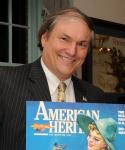-
Spring 2020
Volume65Issue2
I think it's great that American Heritage is stirring, and was pleased to get an email about the latest issue. But I was less enthusiastic about the topic.
Though I understand the idea of "America in Crisis" may have been to show we've been through tough times before (and we'll get through these tough times as well), but in general I just can't take any more crisis. There has been so much debilitating destruction, capped by coronavirus. I sit at home, doing my best to avoid the news, fed up with non-stop crisis.
--Larry Herbst, Pasadena, CA

